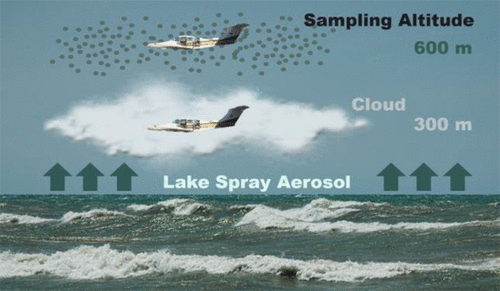当前位置:
X-MOL 学术
›
ACS Earth Space Chem.
›
论文详情
Our official English website, www.x-mol.net, welcomes your feedback! (Note: you will need to create a separate account there.)
Lake Spray Aerosol Incorporated into Great Lakes Clouds
ACS Earth and Space Chemistry ( IF 3.4 ) Pub Date : 2019-11-18 , DOI: 10.1021/acsearthspacechem.9b00258 Nicole E. Olson , Nathaniel W. May , Rachel M. Kirpes , Alexa E. Watson , Kristian D. Hajny , Jonathan H. Slade , Paul B. Shepson , Brian H. Stirm , Kerri A. Pratt , Andrew P. Ault
ACS Earth and Space Chemistry ( IF 3.4 ) Pub Date : 2019-11-18 , DOI: 10.1021/acsearthspacechem.9b00258 Nicole E. Olson , Nathaniel W. May , Rachel M. Kirpes , Alexa E. Watson , Kristian D. Hajny , Jonathan H. Slade , Paul B. Shepson , Brian H. Stirm , Kerri A. Pratt , Andrew P. Ault

|
Aerosol particles are generated by wind-driven processes in regions with large bodies of freshwater, but the impact of these particles on cloud properties and processes is poorly understood. Lake spray aerosol (LSA) production from freshwater wave breaking has the potential to contribute to cloud formation and modify cloud properties by acting as cloud condensation nuclei (CCN) and ice nucleating particles (INPs). To examine whether LSA reaches cloud height and is incorporated into clouds over the Laurentian Great Lakes, sampling of atmospheric particles and cloud water was conducted over Lake Michigan during a summertime wave-breaking event with wave heights of >1.4 m and wind speeds of >9 m s–1. Single-particle microscopy and spectroscopy identified ambient LSA that had composition (CaCO3 and organic material) and morphology (spherical) consistent with LSA generated in the laboratory from surface freshwater collected at the time of ambient sampling. Cloud water was aerosolized in the laboratory, and the resulting composition and morphology of the insoluble residues were similar to ambient and laboratory-generated LSA particles. Elemental mole ratios of LSA and cloud water demonstrated that clouds over the Great Lakes contain similar inorganic salt composition to that of LSA and freshwater lakes. Therefore, LSA is likely a source of CCN and possibly INPs over the Great Lakes, which could potentially influence lake-effect cloud formation and properties. This has important implications for cloud microphysical and radiative properties in the Great Lakes region, as well as other areas with large bodies of freshwater.
中文翻译:

湖喷雾气溶胶纳入大湖云
在具有大量淡水的区域中,通过风驱动过程会生成气溶胶颗粒,但人们对这些颗粒对云的性质和过程的影响知之甚少。淡水波浪破碎产生的湖喷气溶胶(LSA)可能通过充当云凝结核(CCN)和冰成核颗粒(INP)来促进云的形成并改变云的性质。为了检查LSA是否达到云层高度并将其整合到Laurentian大湖中的云层中,在夏季浪高> 1.4 m,风速> 9的夏季破浪事件中对密歇根湖进行了大气颗粒和云层水的采样ms –1。单粒子显微镜和光谱法确定了具有组成(CaCO 3和有机物质)和形态(球形)与实验室从环境采样时收集的地表淡水产生的LSA一致。实验室中对云水进行了雾化处理,所得不溶性残留物的组成和形态与环境和实验室生成的LSA颗粒相似。LSA和云水的元素摩尔比表明,大湖中的云与LSA和淡水湖中的无机盐成分相似。因此,LSA可能是大湖地区CCN的来源,也可能是INP的来源,这可能会影响湖泊效应云的形成和性质。这对五大湖地区以及其他拥有大量淡水的地区的云微物理和辐射特性具有重要意义。
更新日期:2019-11-18
中文翻译:

湖喷雾气溶胶纳入大湖云
在具有大量淡水的区域中,通过风驱动过程会生成气溶胶颗粒,但人们对这些颗粒对云的性质和过程的影响知之甚少。淡水波浪破碎产生的湖喷气溶胶(LSA)可能通过充当云凝结核(CCN)和冰成核颗粒(INP)来促进云的形成并改变云的性质。为了检查LSA是否达到云层高度并将其整合到Laurentian大湖中的云层中,在夏季浪高> 1.4 m,风速> 9的夏季破浪事件中对密歇根湖进行了大气颗粒和云层水的采样ms –1。单粒子显微镜和光谱法确定了具有组成(CaCO 3和有机物质)和形态(球形)与实验室从环境采样时收集的地表淡水产生的LSA一致。实验室中对云水进行了雾化处理,所得不溶性残留物的组成和形态与环境和实验室生成的LSA颗粒相似。LSA和云水的元素摩尔比表明,大湖中的云与LSA和淡水湖中的无机盐成分相似。因此,LSA可能是大湖地区CCN的来源,也可能是INP的来源,这可能会影响湖泊效应云的形成和性质。这对五大湖地区以及其他拥有大量淡水的地区的云微物理和辐射特性具有重要意义。


























 京公网安备 11010802027423号
京公网安备 11010802027423号